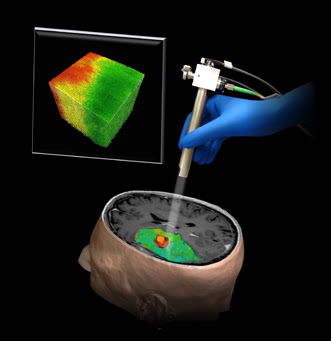BALTIMORE, June 19, 2015 — Optical coherence tomography (OCT) holds promise as a tool to guide surgeons as they operate on brain tumors, helping them to avoid removing healthy tissue.
After identifying brain cancer's OCT signature, researchers at Johns Hopkins University have developed a computer algorithm that rapidly generates a color-coded map that shows cancer in red and healthy tissue in green.
"We envision that the OCT would be aimed at the area being operated on, and the surgeon could look at a screen to get a continuously updated picture of where the cancer is — and isn't," said professor Xingdi Li.
So far the system has been tested on fresh human brain tissue removed during surgeries and in surgeries to remove brain tumors from mice. The researchers hope to begin clinical trials in patients this summer.
Neurosurgeons walk a tightrope as they try to remove as much of the cancer as possible while keeping crucial brain tissue intact. Visually distinguishing the two is often impossible.
"As a neurosurgeon, I'm in agony when I'm taking out a tumor," said Dr. Alfredo Quinones-Hinojosa, a professor of neurosurgery, neuroscience and oncology at the Johns Hopkins University School of Medicine and clinical leader of the research team. "If I take out too little, the cancer could come back; too much, and the patient can be permanently disabled. We think optical coherence tomography has strong potential for helping surgeons know exactly where to cut."

Optical coherence tomography could help surgeons differentiate a human brain tumor, red, from surrounding noncancerous tissue, green. Courtesy of Kut et al./Johns Hopkins Medicine.
First developed in the early 1990s for imaging the retina, OCT operates on the same echolocation principle used by bats and ultrasound scanners, but it uses light rather than sound waves, yielding a higher-resolution image than does ultrasound. And unlike x-rays and CT or PET scans, OCT uses nonionizing radiation to produce images.
Cancers tend to be relatively dense, which affects how they scatter and reflect light. Brain cancer cells also lack the myelin sheaths that coat healthy brain cells, a factor that has even greater effect on OCT readings than cell density, the researchers said.
If clinical trials are successful and the system goes to market, it will be a big step up from imaging technologies now available during surgeries, Quinones-Hinojosa said.
"Ultrasound has a much lower resolution than OCT, and MRI scanners designed to be wheeled over a patient on the operating table cost several millions of dollars each — and require an extra hour of operating room time to obtain a single image," he said.
By comparison, the team anticipates that an OCT-based system would cost hundreds of thousands of dollars.
The system could be adapted to detect cancers in other parts of the body, said doctoral student Carmen Kut. She is working on combining OCT with a different imaging technique that would detect blood vessels to help surgeons avoid cutting them.
The research was published in Science Translational Medicine (doi: 10.1126/scitranslmed.3010611).
For more information, visit www.hopkinsmedicine.org.